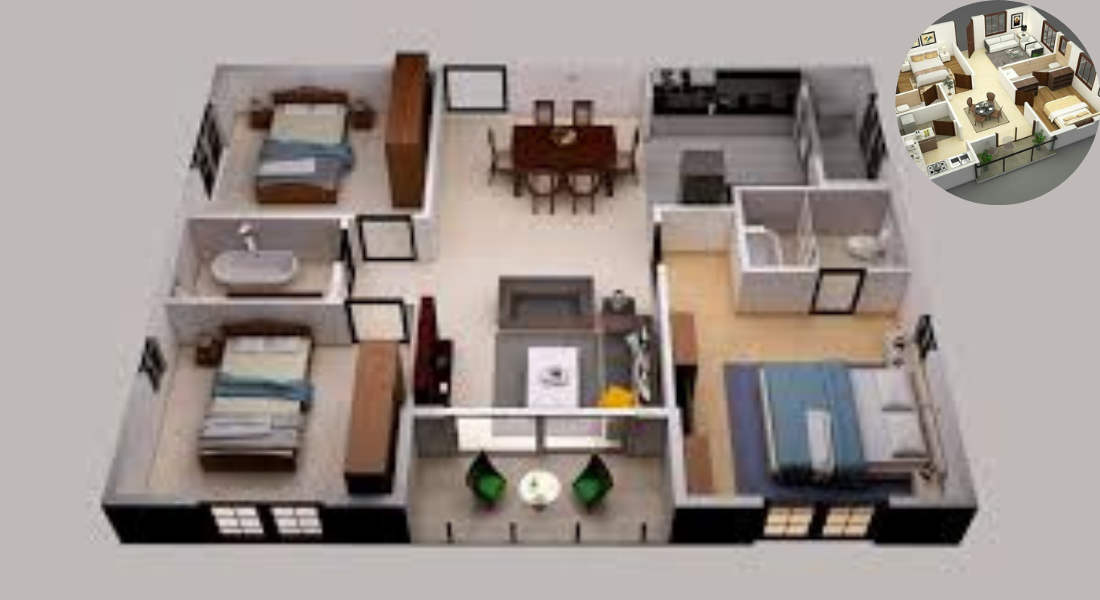Designing your own house floor plan is one of the most exciting and rewarding parts of building or remodelling your dream home. It’s the perfect opportunity to create a space that reflects your personality, lifestyle, and future needs. But let’s face it—designing a house floor plan can feel overwhelming if you’re not sure where to start.
What is a Floor Plan and Why Does it Matter?
A floor plan is a scaled diagram that shows the layout of a house from an overhead perspective. It outlines the arrangement of rooms, windows, doors, walls, and other structural elements. In essence, a floor plan is the blueprint of your home’s Functionality and flow.
Why is a Floor Plan Important?
A well-thought-out floor plan defines your home’s comfort, Functionality, and aesthetics. It ensures that every square foot of your home serves a purpose, reflects your lifestyle, and meets your family’s needs. Whether you’re designing a compact apartment or a sprawling mansion, the floor plan is the foundation of a great home design.
Understanding the Basics of Floor Plan Design
Before diving into the actual design process, it’s crucial to understand the fundamentals of floor planning. Here’s what you need to know to get started.
Key Elements to Consider Before You Start
- Purpose and Scope
- Begin by defining the objectives of your project. Are you designing for open-concept living, adding extra bedrooms, or creating a multifunctional space? Clarity on your goals will guide your decisions.
- Square Footage
- Decide how much space you have to work with. Are you working with a fixed lot size or expanding an existing home? Understanding your spatial limitations is essential.
- Lifestyle Needs
- Your floor plan should reflect how you’ll use the space daily. For instance, families with kids may prioritise open play areas, while remote workers need a dedicated office.
Essential Tools for Floor Plan Design
Designing a floor plan requires the right tools. Here are two popular options:
- Traditional Tools: Graph paper, pencils, rulers, and erasers are great for sketching out rough ideas.
- Digital Tools and Software: Use programs like SmartDraw, RoomSketcher, or Coohom Floor Planner to create precise designs and experiment with layouts.
Key Principles for Effective Floor Plans
The best floor plans are not just visually appealing—they’re practical and functional. Let’s explore the core principles of designing an effective house floor plan.
Prioritise Functionality
Every square foot of your home should serve a purpose. Think about the primary function of each room and ensure its size and layout align with its intended use. For example, in a kitchen, the work triangle (sink, stove, refrigerator) should allow for easy movement.
You may also read (clayton homes hewitt floor plan).
Consider Traffic Flow
Smooth traffic flow is essential to make your home feel spacious and accessible. Avoid bottlenecks and obstructions in high-traffic areas like hallways and entryways. Ensure doorways and passageways are wide enough for comfortable movement.
Balance Openness and Privacy
Modern homes often blend open layouts with private areas. For example, open-concept living areas foster connection, while bedrooms and bathrooms maintain privacy. Zoning helps create distinct spaces without disrupting the overall flow.
Maximise Natural Light
Natural light not only enhances your home’s aesthetics but also improves energy efficiency. Pay attention to window placement and the home’s orientation to make the most of sunlight.
Plan for Flexibility
Life evolves, and so will your needs. Create spaces that can adapt over time. For instance, a guest room may double as a home office, or a playroom may convert into a bedroom as your family grows.
Step-by-Step Guide to Designing Your Own Floor Plan
Now that you understand the principles, let’s break down the floor plan design process into actionable steps.
Needs Assessment and Goal Setting
- Identify your family’s needs and lifestyle.
- Make a list of essential features (e.g., number of bedrooms, office space).
- Differentiate between needs (e.g., functional kitchen) and wants (e.g., luxury walk-in closet).
Sketching and Conceptualisation
- Start with a rough sketch of the layout.
- Experiment with different room placements and flow between spaces.
- Consider outdoor connections, such as patios or gardens.
Measuring and Scaling
- Measure your building site or existing space accurately.
- Use a scale (e.g., 1 inch = 1 foot) to create a precise plan.
- Include fixed elements like walls, windows, and doors.
Space Planning and Room Layout
- Define the purpose of each room and its size.
- Arrange furniture to ensure Functionality and comfort.
- Don’t forget storage solutions like closets or built-in shelves.
Refining the Design
- Review your design for inefficiencies or issues like poor traffic flow.
- Make adjustments to improve natural light, ventilation, and practicality.
- Ensure your design complies with local building codes.
Incorporating Technical Details
- Mark locations for electrical outlets, plumbing, and lighting.
- Plan for HVAC systems and insulation.
- Specify materials and finishes for floors, walls, and ceilings.
Common Design Mistakes to Avoid
To save time, money, and frustration, steer clear of these common floor plan mistakes:
- Poor Traffic Flow: Avoid narrow hallways and cramped spaces that hinder movement.
- Inadequate Lighting: Don’t rely solely on artificial light—maximise natural light sources.
- Lack of Storage: Always include sufficient storage space, such as closets and cabinets.
- Ignoring Building Codes: Ensure your design complies with local regulations.
- Forgetting Future Needs: Design for flexibility to accommodate future changes.
You may also read (floor damage on your home).
Maximising Space and Functionality
Whether you’re working with a small home or a large one, optimising space is key. Here are some tips:
Multifunctional Spaces
- Combine uses for rooms, like a home office that doubles as a guest room.
- Use furniture that serves multiple purposes, such as foldable desks or sofa beds.
Open Concept vs. Defined Spaces
- Open layouts create a sense of spaciousness but may lack privacy.
- Defined spaces offer separation, but can feel confined. Strike a balance based on your needs.
Smart Storage Solutions
- Use built-in shelves, under-stair storage, or hidden compartments.
- Vertical storage options like tall bookcases maximise unused wall space.
Utilise Vertical Space
- High ceilings and wall-mounted storage make small spaces feel larger.
- Use loft areas for additional storage or seating.
Incorporating Sustainable Design Elements
Sustainability is becoming a priority for many homeowners. Here’s how to incorporate eco-friendly elements into your floor plan:
Energy Efficiency
- Use energy-efficient windows, doors, and insulation.
- Orient your home to maximise natural light and reduce heating/cooling costs.
Eco-Friendly Materials
- Choose sustainable materials like bamboo flooring or reclaimed wood.
- Use low-VOC paints and finishes to improve indoor air quality.
Water Conservation
- Install water-efficient fixtures and appliances.
- Consider a rainwater harvesting system for irrigation.
Working with Professionals
While designing your own house floor plan is exciting, you might benefit from working with professionals for complex projects.
When to Hire an Architect or Designer
- If your project involves structural changes or unique challenges, an architect can help.
- Professionals ensure compliance with building codes and regulations.
How to Find the Right Professional
- Check portfolios and references to assess their expertise.
- Choose someone who understands your vision and listens to your needs.
You may also read (buy a floor plan).




